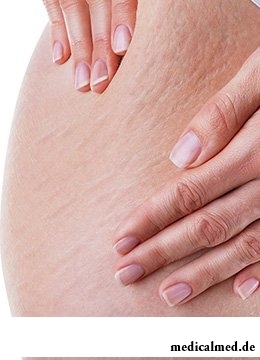





Removal of hems
The procedure of removal of hems is generally carried out because they do not disappear over time, and in a varying degree represent cosmetic defect.
 The hem is the dense connecting education arising owing to an angenesis after an inflammation or damage. For example, hems appear on skin after healing of wounds, in a myocardium – after a heart attack, in a duodenum – after an ulcer.
The hem is the dense connecting education arising owing to an angenesis after an inflammation or damage. For example, hems appear on skin after healing of wounds, in a myocardium – after a heart attack, in a duodenum – after an ulcer.
The choice of a method of removal of hems depends both on their type, and on that how long ago they appeared.
Types of hems and reason of their emergence
Dermatologists and cosmetologists constantly face need of removal of postoperative hems. Besides, growth of connecting fabric is probable after injuries or burns, and also as a result of some acute and chronic skin diseases, such as acne rash or chicken pox. At first hems have a reddish shade, and afterwards are depigmented. The characteristic of hems depends on the following factors:
- Localization and depth of a wound;
- Incorrect treatment of damage;
- Disbolism (atherosclerosis, diabetes, hypovitaminosis);
- Age (hems at adults are noticeable less, than at children and teenagers);
- Specific features (the wrong scarring meets at red-haired and black people more often);
- Genetic predisposition.
X-ray and ultraviolet radiation, and also infection of a wound also exert impact on formation of hems.
The way of removal of hems can depend on type of formation of this defect. Hypertrophic, or keloid cicatrixes, act over an integument as a result of excess production of collagen and formation of a large amount of fabric. Elastin is almost not involved in this process. In the field of a hem darkening of skin, an itch and pain are noted. After appropriate treatment and recovery of a corneous layer of skin the hem is leveled and gets a natural shade.
Removal of hems of atrophic type also helps to get rid of a serious cosmetic shortcoming. At this type of scarring the opposite picture is observed – defect is lower than the level of skin, has pale color and a hyposensitivity. After various skin diseases, for example cystous eels, there are sites where the derma becomes thinner and almost completely there is no hypodermic fatty tissue. In these parts there are impressions.
Scarring in the form of craters or poles is most characteristic of an acne and chicken pox. Leads insufficient formation of fabric under a skin layer which was destroyed by rash to formation of the "chopped-off" hems. Expressiveness of defect depends on a stage and weight of the postponed inflammatory processes.
As a result of a natural wound repair thin white hems are sometimes formed. They are not subject to traditional methods of treatment and can expand after grinding or stripping of an upper layer of a derma. At hypopigmentation, according to reviews, with success apply silicone plates by means of which create air hunger to removal of hems and by that reduce collagen synthesis.
After small damages, for example slight burns or acne rash, skin can get a brown or crimson shade. The hyperpegmentation results from excess production of melanin and is capable to remain throughout the long period.
If fabric expands without disturbance of integrity of skin, then probably the cicatricial atrophy takes place. The polosovidny atrophy of skin is its example. Formation of striya, or extensions, usually happens at sharp increase in body weight, and also during pregnancy and breastfeeding.
Methods of removal of hems
Most often as the reason of the address to the dermatologist serve postoperative hems which removal is the best way to get rid of the expressed traces of surgical intervention. There are following methods of correction:
- Drug treatment;
- Beeches therapies;
- Mesotherapy;
- Cryolysis;
- Surgical excision;
- Grinding.
Rassasyvaniya and to healing of hems various ointments which recover the broken blood circulation promote and accelerate an angenesis. Usually drugs combine with physical therapy.
Beeches therapies it is applied to removal of postoperative hems of hypertrophic type. Blankets are exposed to x-ray radiation therefore growth and deformation of cicatricial fabric stops.
Introduction under skin of small doses of various drugs at a mesotherapy influences small hems, and also allows to get rid of a nevus pigmentosus and small wrinkles.
The cryolysis liquid nitrogen freezes pathological fabrics, breaking life activity of cells. This method of removal of hems, according to specialists, has almost no contraindications and does not demand anesthesia.
 Surgical excision is shown at small hems. After elimination of excess of connecting fabric put intradermal cosmetic stitches. The characteristic of a new hem depends on many factors, and it is possible to estimate final result of operation not earlier, than in 3 months.
Surgical excision is shown at small hems. After elimination of excess of connecting fabric put intradermal cosmetic stitches. The characteristic of a new hem depends on many factors, and it is possible to estimate final result of operation not earlier, than in 3 months.
Dermabrasion represents a mechanical way of grinding of skin for removal of hems of any complexity, including recently acquired. The procedure consists in removal of a blanket of a derma by means of a special set of mills. Dermabrasion cannot be carried out on sites with a difficult relief and thin skin, for example, in the field of a century.
The principle of removal of hems the laser consists in layer-by-layer grinding of old connecting fabric and stimulation of development of elastic and collagenic fibers. The most sparing is considered the erbium laser which is operating locally and not affecting healthy skin.
Many specialists prefer to carry out removal of hems by the laser owing to sensitivity and high precision of this method which is not allowing deep damage of fabrics.
If your liver ceased to work, death would come within a day.

Several decades ago the basil (the district khan, реан, Reagan) was considered as a part of the Caucasian or east cuisine, but today it is strong for...
Section: Articles about health
With age in a human body harmful substances collect. We receive them with food and water, at inhalation of the contaminated air, reception of medicines, use of household chemicals and cosmetics. A considerable part of toxins accumulates in a liver, osnovno...
Section: Articles about health
For anybody not a secret that the modern person eats not as his ancestors. For the last 100 years in broad access there were absolutely new products which are result of use of the latest technologies in food production. Significantly ways of storage and transportation of food ingredients changed, and people of the whole world had an opportunity to regularly use those products about which their grandfathers and grandmothers did not even know....
Section: Articles about health
Life activity of one-celled fungi of the sort Candida is a proximate cause of development of candidiasis (milkwoman), it is related...
Section: Articles about health
Nightmares belong to the most unpleasant frustration. Statistically, they happen at 4% of adults, and almost at 70% of children and teenagers. During a nightmare of people dreams himself in extremely difficult, life-threatening situation. It wakens suddenly, in...
Section: Articles about health
On the head of the person about one million hair follicles, or as they are called still, hair bulbs are located. At the time of the birth most of them is in the "sleeping" state, but within several weeks follicles become more active, and from them hair begin to grow. Intensity of this process is individual, and during life it can change. Genetic predisposition, a physical and emotional state, aggressive influence affects the growth rate of hair out of...
Section: Articles about health
Cold is such painful that each sigh becomes a victory, heat "knocks" down, and the ache in joints forces to think only about...
Section: Articles about health
Tuberculosis – a serious infectious disease which development is caused by mycobacteria (Koch's bacilli). The illness is known from an extreme antiquity. Long time fight against it was considered as ineffective. Quite often the disease affected the whole families, and mortality from it was very much...
Section: Articles about health
Color of plants is caused by presence at them of certain chemical compounds. Let's talk about what is meant by various colors of vegetables and fruit and what properties they give them....
Section: Articles about health
You heard that laughter prolongs life? To establish longevity direct link with sincere fun to researchers yet not удалос...
Section: Articles about health
For most of the working people the problem of having a snack is particularly acute enough. Sooner or later there is a question: what can be eaten quickly between a breakfast and a lunch or a lunch and leaving from service so that to receive necessary power feed, but not an overload...
Section: Articles about health
The fatigue, sleep debt, disturbances of food, bad mood, vagaries of the weather – all these circumstances badly affect our appearance. Especially the person suffers: skin becomes flabby, loses healthy color, becomes covered by wrinkles, zones of hypostases and dark circles under eyes appear. It is not always possible to be saved from influence of aggressive factors, but we are quite able to minimize its effects. For this purpose usually apply the cosmetics and procedures helping увлаж...
Section: Articles about health
Smack in a mouth can arise in the natural way – as a result of lack of morning hygiene or reception of the corresponding food. Odn...
Section: Articles about health
One of the major chemical processes happening in a human body are oxidation reactions. They go with participation of fats and carbohydrates which we receive from food, and the oxygen getting to us from air. A main goal of such reactions is it is received...
Section: Articles about health
Beauty shop – the place which is associated only with positive emotions: joy, pleasure, relaxation. However visit of salon where work with biological material of clients, not always harmlessly is conducted. Today more than 100 pathogenic microorganisms who can catch in beauty shop including deadly to health are known....
Section: Articles about health
Cystitis, or inflammation of a mucous membrane of a bladder, this very widespread disease, which, owing to some persons...
Section: Articles about health
The brain of the person is studied not one hundred years, but the quantity of the riddles connected with this body increases rather, than decreases. Perhaps, numerous delusions concerning a structure and functioning of a brain, many are explained by it from...
Section: Articles about health
All like to sing. Small children with pleasure are engaged in a vocal, not especially thinking of hit in a melody. Adults most often hesitate, being afraid to show lack of talents in this area, and it is vain: singing is very useful for health....
Section: Articles about health
Diapers for adults – individual one-time means of hygiene which in some situations is irreplaceable, and from such situats...
Section: Articles about health
Food with the increased content of sugar is attractive to most of people - it is scientifically confirmed fact. Business here not in intemperance or dissoluteness: the sweet food is associated since childhood with feeling of rest and safety which is felt by the kid, to...
Section: Articles about health
Cold, puffiness of a nose, itch, the watering eyes - characteristic symptoms of the allergic rhinitis resulting from hit of allergens (pollen, house dust, hair of animals, etc.) on a mucous membrane of a nose. Unpleasant feelings often give trouble, serving as the reason of a headache, an acrimony, sleep disorders, and in certain cases and the states close to a depression. How to get rid of undesirable satellites of a disease if near at hand there are no antiallergic...
Section: Articles about health
About 20% of the population of our planet have a hypertension (permanent increase in arterial pressure). This disease negatively narrations...
Section: Articles about health
Many of us, probably, noticed more than once that from intellectual loadings at some point the brain as though "overheats" and "assimilation" of information is strongly slowed down. Especially this problem urgent for persons of age becomes more senior than fifty years. "It is already bad with...
Section: Articles about health
The varicosity has familiarly many, statistically, this disease more than a half of all adult population. As a rule, the varicosis affects preferential superficial vessels, and is shown by characteristic cosmetic defects. The deep vein thrombosis as this illness at the initial stages can imperceptibly proceed is represented much more dangerous, and in the started cases threatens with serious danger – thrombosis. This state, when the blood clot formed...
Section: Articles about health
The drugs stopping or oppressing life activity of pathogenic microorganisms are widely applied in clinical practice with 4...
Section: Articles about health
Stroke (acute disorder of cerebral circulation) – one of the most widespread neurologic diseases. Annually in the world more than 6 million people die of this illness. From the survived patients about 80% become disabled people, and nearly a thirds from them впо...
Section: Articles about health
For many women the word "fat" sounds as a sentence. In aspiration to an ideal figure they try to exclude, first of all, from the menu all dishes containing fats without having at the same time a clear idea of a role of these substances in exchange processes, and of effects for health with which food restrictions of this sort are fraught. For what the human body needs fats and as their deficit in a diet is shown, we also will try to find out....
Section: Articles about health
